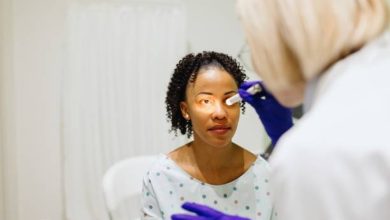6 Ways to Overcome Fibroid Drug Side Effects


The most common form of benign tumor in women during their reproductive years, uterine fibroids affect up to 80 percent of women worldwide by age 50.
Usually diagnosed during the 30s and 40s, fibroids actually affect Black women three times as often as other races. More than that, the average Black girl first experiences fibroids in her 20s, compared to the 30s and 40s for other races.
Given that Black women are also more likely to be hospitalized, require surgery, and have severe symptoms, fibroids are no joke.
This is why medication can play such a critical role. But here’s the catch. As bad as some fibroids can get, sometimes, the treatment has its own share of problematic effects!
If you or someone you know is medicated for fibroids, here are six ways to beat those pesky side effects!
1. Progesterone-Releasing Intrauterine Device (IUD)
A tiny device planted in the uterus to unleash hormones, the IUD may be the best option for lessening fibroid-related menstrual bleeding. However, this treatment may also worsen bleeding, cause spotting, lead to breast sensitivities, and even cause mood swings.
So here’s how to beat the side effects…
For bleeding issues, menstrual cups and pads are ideal. If your breasts become tender, many OTC pain relievers, like ibuprofen, should do the job. A bra with extra support is also useful. And finally, if mood swings are hurting you, mindfulness activities can help balance you out. Whether it’s yoga, acupuncture, or grounding on the bare ground, they all have their benefits.
2. Gonadotropin-Releasing Hormone (GnRH) Agonists
Another long-sounding name, GnRH agonists work by shrinking fibroids by putting your body in a menopausal condition. The problem with this, of course, is you can get side effects of menopause.
For hot flashes and night sweats, it’s important to adjust your environment. You can do this by dressing in layers, changing your home temperature, and drinking cold beverages to lower your body temperature.
Dealing with bone loss? Make sure to supplement with calcium and vitamin D and don’t be afraid of mild activities that strengthen your bones, whether simple walks or body-resistance exercises.
As for mood swings, the best thing you can do is take a holistic approach. Speak to your doctor about the best diet, workout routine, and mindful activities for your lifestyle.
3. Nonsteroidal Anti-Inflammatory Drugs (NSAIDs)
You may not know it, but the commonly used ibuprofen is considered an NSAID. But even something as widely sold as ibuprofen can cause issues such as stomach discomfort, ulcers, and other gastrointestinal problems. In other words, even though NSAIDs are supposed to treat inflammation (like that caused by fibroids), sometimes they only increase it!
The steps to address these side effects are simple. Make sure to eat when you take the medicine, and consider antacids to offset gastrointestinal problems. Another thing to do is drink a lot of water constantly while eating foods high in fiber, which can normalize your bowels.
Good luck!
4. Tranexamic Acid
By triggering blood clotting, tranexamic acid can halt menstrual bleeding. Unfortunately, it can also lead to nausea, headaches, and diarrhea. Tired of this stuff? The good news is, the treatments are pretty simple. Like always, stay hydrated, eat healthy foods, and do your best to manage headaches. If pain relievers, plenty of water, and healthy foods don’t work, talk to your doctor about other changes.
RELATED: Fibroids and Fertility: What Every Black Woman Needs to Know
5. Birth Control Pills
Commonly prescribed to normalize periods and help with fibroids, birth control can also cause weight fluctuations, breath sensitivity, nausea, and shifts in mood. If you’re having these issues, first consider reducing caffeine and salt, as this can help with breast discomfort. Secondly, take the pill when you eat, or before you go to sleep. Ginger supplements can definitely help with nausea as well.
As for the weight gain and mood changes? It’s all about promoting a healthy body and mind, which starts with quality food, consistent exercise, and mindfulness. Talk to your doctor for a personalized treatment plan based on your blood work.
6. Selective Progesterone Receptor Modulators (SPRMs)
Last but not least are SPRMs, which affect hormones that lead to fibroid growth. To treat the hot flashes, headaches, and muscle discomfort that may arise, it’s no sweat. For hot flashes, consider layers and keeping cool – both with what you drink and your immediate environment. As with the other side effects, pain relievers can help (but shouldn’t be abused). It’s better to get regular exercise, take some warm baths, and stretch.
By adopting the recommended approaches in this article, any woman can overcome the treatment side effects for fibroids, and handle those darn growths once and for all!




